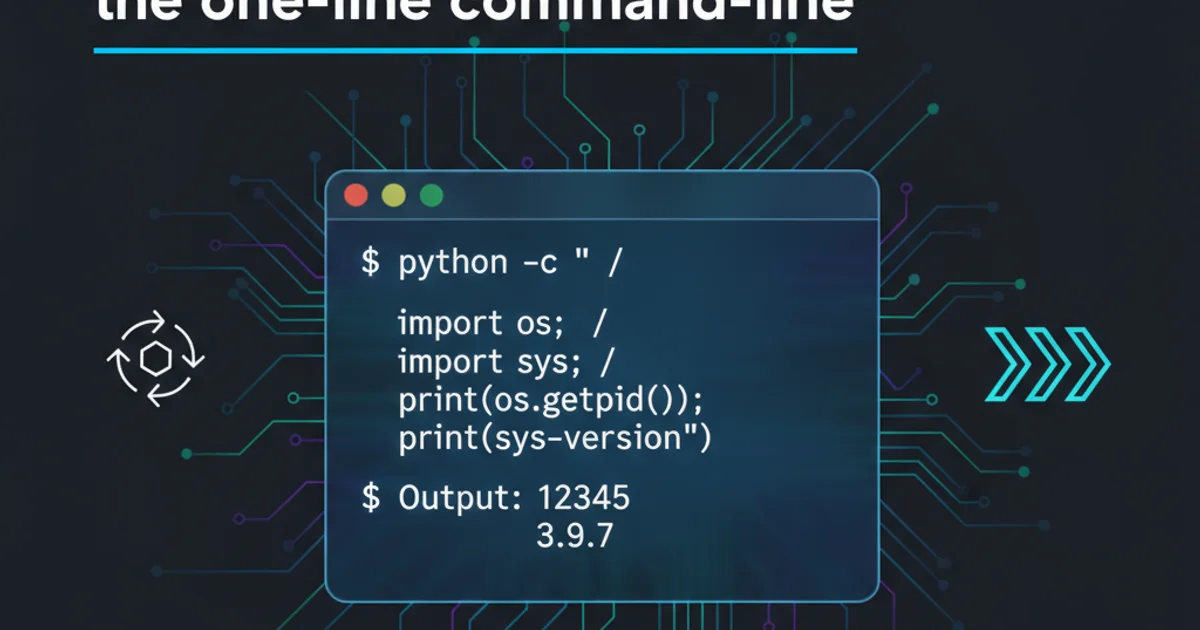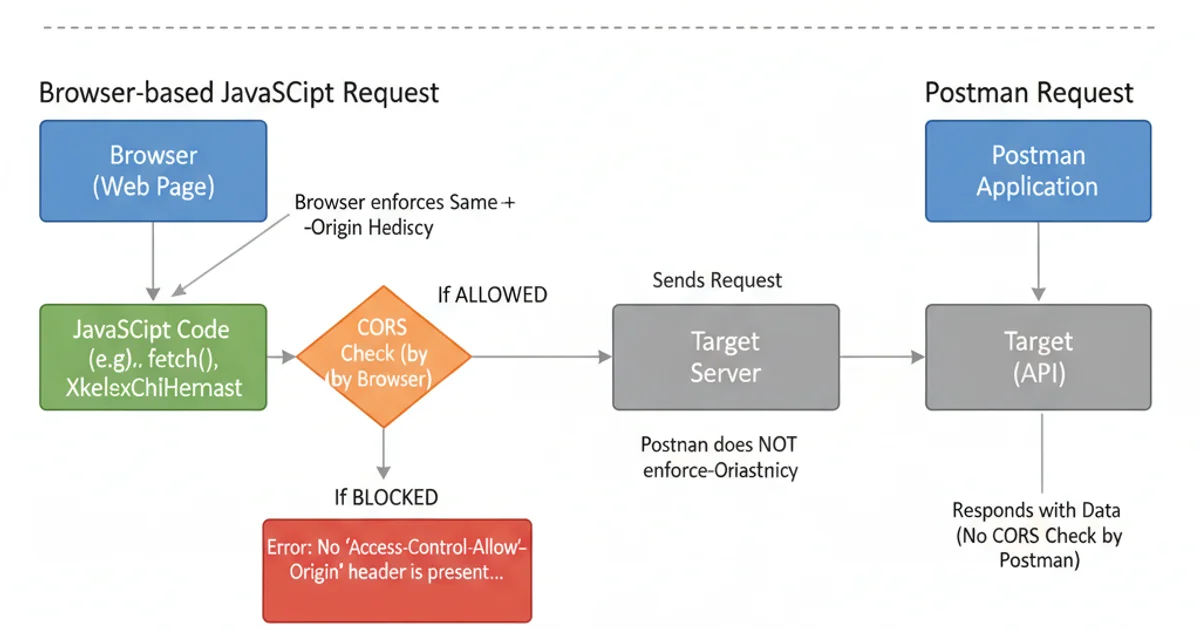Why does my JavaScript code receive a "No 'Access-Control-Allow-Origin' header is present on the ...
Categories:
Why JavaScript CORS Errors (Access-Control-Allow-Origin) Don't Affect Postman

Understand the fundamental differences between browser-based JavaScript requests and tools like Postman that lead to 'Access-Control-Allow-Origin' errors, and how to resolve them.
You're developing a web application, making an API call from your JavaScript code, and suddenly you hit a wall: Access to XMLHttpRequest at 'http://api.example.com/data' from origin 'http://localhost:3000' has been blocked by CORS policy: No 'Access-Control-Allow-Origin' header is present on the requested resource. Yet, when you paste the exact same URL into Postman, it works perfectly. This common frustration stems from a fundamental security mechanism in web browsers called the Same-Origin Policy (SOP) and its counterpart, Cross-Origin Resource Sharing (CORS). This article will demystify why this happens and how to address it.
The Same-Origin Policy (SOP) and CORS
The Same-Origin Policy is a critical security feature implemented by all modern web browsers. It dictates that a web page can only request resources (like data from an API) from the same origin that served the web page itself. An 'origin' is defined by the combination of protocol (e.g., http, https), host (e.g., example.com, localhost), and port (e.g., 80, 3000). If any of these three components differ, the origins are considered 'cross-origin'.
flowchart TD
A[Browser loads page from Origin A] --> B{JavaScript makes request to Origin B?}
B -->|Yes| C{Is Origin A == Origin B?}
C -->|Yes| D[Request Allowed]
C -->|No| E{Is CORS enabled on Origin B for Origin A?}
E -->|Yes| D
E -->|No| F[CORS Error: Request Blocked by Browser]
F --> G[Postman/cURL can still access Origin B directly]Browser's Same-Origin Policy and CORS Check
When your JavaScript code running on http://localhost:3000 tries to fetch data from http://api.example.com, it's a cross-origin request. By default, the browser blocks this to prevent malicious scripts from one site from reading sensitive data from another. Cross-Origin Resource Sharing (CORS) is a mechanism that allows servers to explicitly permit cross-origin requests from specific origins. It's an opt-in security feature controlled by the server, not the client.
Why Postman Bypasses CORS
The key difference lies in who is making the request. When your JavaScript code makes an XMLHttpRequest or fetch request, it's the browser that enforces the Same-Origin Policy and checks for CORS headers. If the server doesn't send the appropriate Access-Control-Allow-Origin header, the browser intercepts the response and throws the error, preventing your JavaScript from accessing the data.

Browser vs. Postman: The CORS Enforcement Difference
Postman, on the other hand, is a standalone application (or a browser extension that acts like one, bypassing browser security for its own requests). It's not subject to the browser's Same-Origin Policy. When Postman sends a request, it's a direct HTTP request from the Postman client to the server, much like using curl from your terminal. The server responds, and Postman simply displays whatever the server sends back, without any browser-imposed security checks.
Resolving the 'Access-Control-Allow-Origin' Error
To fix this error, you need to configure the server (the API you're trying to access) to include the necessary CORS headers in its responses. This tells the browser that it's safe to allow your JavaScript code to access the resource.
Node.js (Express)
const express = require('express');
const cors = require('cors');
const app = express();
// Use the cors middleware
app.use(cors({
origin: 'http://localhost:3000' // Replace with your frontend origin
}));
app.get('/data', (req, res) => {
res.json({ message: 'Data from API' });
});
app.listen(3001, () => {
console.log('API listening on port 3001');
});
PHP
<?php
header('Access-Control-Allow-Origin: http://localhost:3000'); // Replace with your frontend origin
header('Access-Control-Allow-Methods: GET, POST, OPTIONS');
header('Access-Control-Allow-Headers: Content-Type, Authorization');
// Handle preflight OPTIONS request
if ($_SERVER['REQUEST_METHOD'] == 'OPTIONS') {
exit(0);
}
// Your API logic here
echo json_encode(['message' => 'Data from API']);
?>
Python (Flask)
from flask import Flask, jsonify
from flask_cors import CORS
app = Flask(__name__)
CORS(app, origins=['http://localhost:3000']) # Replace with your frontend origin
@app.route('/data')
def get_data():
return jsonify(message='Data from API')
if __name__ == '__main__':
app.run(port=5000)
Apache (.htaccess)
<IfModule mod_headers.c>
Header set Access-Control-Allow-Origin "http://localhost:3000" # Replace with your frontend origin
Header set Access-Control-Allow-Methods "GET, POST, OPTIONS"
Header set Access-Control-Allow-Headers "Content-Type, Authorization"
</IfModule>
Access-Control-Allow-Origin: * allows any origin to access your resource. While convenient for development, it's a security risk in production. Always specify the exact origins that need access.Client-Side Workarounds (Not Recommended for Production)
While server-side configuration is the proper solution, sometimes you need a quick workaround during development when you don't control the API server. These methods should never be used in production for security and reliability reasons.
1. Browser Extensions
Some browser extensions (e.g., 'CORS Unblock') can modify HTTP headers on the fly to bypass CORS for local development. This only affects your browser and is not a solution for users.
2. Proxy Server
You can set up a local proxy server (e.g., using Node.js, Webpack Dev Server, or Nginx) that forwards requests from your frontend to the target API. Since the proxy is on the same origin as your frontend, the browser allows the request. The proxy then makes a direct, server-to-server request to the API, which is not subject to browser CORS rules.
// Example of a Webpack Dev Server proxy configuration
// webpack.config.js
module.exports = {
// ... other webpack config
devServer: {
proxy: {
'/api': {
target: 'http://api.example.com', // The actual API server
changeOrigin: true, // Needed for virtual hosted sites
pathRewrite: { '^/api': '' }, // Remove /api prefix when forwarding
secure: false // For development with self-signed certs
}
}
}
};
Webpack Dev Server proxy configuration to bypass CORS during development.
In summary, the 'Access-Control-Allow-Origin' error is a browser-enforced security measure. Postman doesn't encounter it because it's not a browser and doesn't adhere to the Same-Origin Policy. The definitive solution is always to configure the API server to send the correct CORS headers, explicitly allowing your frontend's origin.